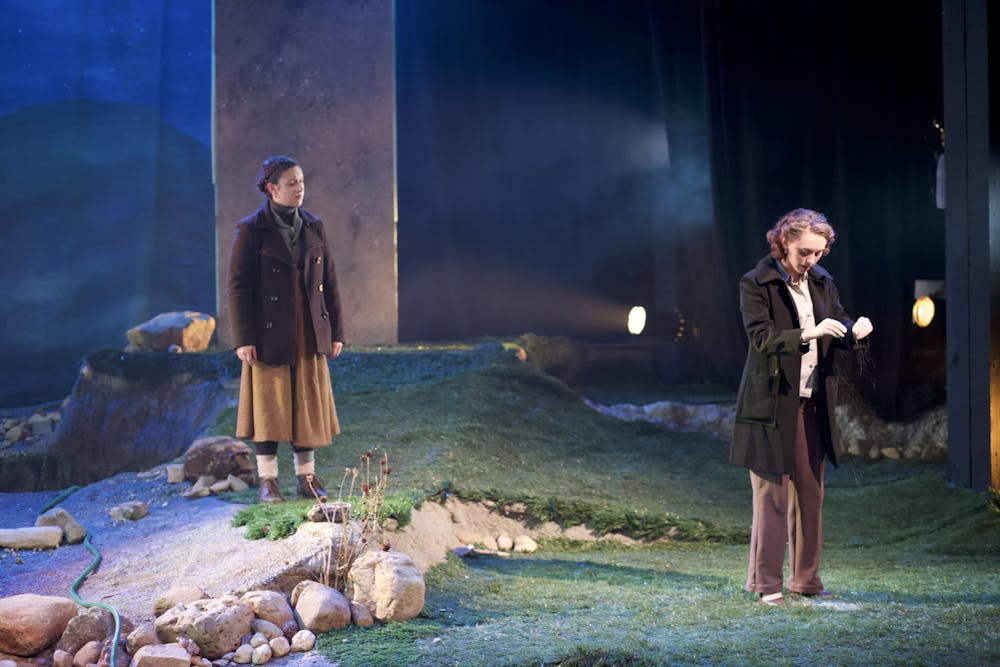Every time a play or musical is performed in Mitchell Theatre, the stage setup looks drastically different. The immense structures, carefully painted details, creative design elements and intentionally placed props all meld together to create a stunning piece of art.
While viewers often notice the actors’ hard work, the crew behind the scenes is putting in just as much effort to make the show possible and successful.
“The theatre community at Taylor is unique because it welcomes actors and technicians of any major or academic affiliation,” Taylor Theatre Technical Director Conner Reagan (‘17) said. “It’s comprised of a group of artists who seek to tell truthful, relevant and thoughtful stories in the context in which we live and work: Upland, Indiana.”
Reagan feels as though his background in mechanical engineering, technical theatre and mathematics helped prepare him for his current position focused on design and construction.
In his position, he is responsible for implementing all of the non-actor parts of the play. These duties include set construction, painting, lighting, costume fitting and design work.
“Thankfully I don’t have to do all those things by myself — I’m in charge of a great team of about a dozen student production staff that collaborate to make it all happen,” Reagan said.
One of these students is Lindsay Rice, a senior theatre arts major.
As Taylor Theatre’s master carpenter, Rice receives design drafts from Reagan. She then takes measurements and uses the drafts she received, along with appropriate materials to put the set together.
Prior to the physical building of the set, the creative team meets together to discuss the director’s vision for the show and important themes that may need to be portrayed.
“The director’s vision is limited by several factors: particularly budget, personnel and the space in which the play is performed,” Reagan said. “Working within these constraints, the design team works in tandem to create a coherent representation of the director’s vision in the set, the lights, the sound design, the costumes, etc.”
With each production comes a unique set of challenges and thrills.
Reagan stressed the importance of problem-solving and its role in building a successful and productive team.
“The challenges that are both difficult and exciting come from the fact that each set is different,” Reagan said. “Sometimes it’s the interior of a mid-century modern home (“Borrowed Babies”), sometimes it’s an ancient burial ground in the hills of Scotland (“The Women of Lockerbie”), sometimes it’s a street corner in depression-era Alabama (“To Kill a Mockingbird”).”
The theatre’s most recent production was “To Kill a Mockingbird.”
The set consisted of pieces that rolled around and attached to each other. This meant that all sides had to be free-standing and look good to the audience.
“The design concept for the whole set was ‘incomplete memories,’” Reagan said. “The story was told from the perspective of recalling childhood events years ago, so everything on stage had to feel remembered and not quite what it actually was. That meant that our team of painters had to figure out how to paint interpretations of wood and marble as if they were remembered from years back.”
Rice recalled a production from her freshman year called, “Metamorphoses.” For this play, the team was tasked with creating a four-foot pool on the stage. When the pool’s lining broke and flooded part of the theatre, the team’s problem-solving skills were put to the test.
Thankfully, the production team was able to clear out the water and fix their problem, but it was a great learning experience for them all.
“Being able to help make the world of the play come to life and adding my own art to the story is probably the most rewarding part, and doing it for the glory of God,” Rice said.
She enjoys seeing the set come together as time progresses. Acknowledging where the team started and then seeing how the set ends up is a beautiful process to watch for Rice.
Since the production staff members are all students, they are able to create a valuable community.
“I feel like we have a more intimate connection with the space and each other because we're not just in the shows,” Rice said. “We're also building the shows from start to finish together.”
The theatre is open to anyone and everyone, no matter what their major may be. Rice expressed how often the theatre can feel secluded from campus, but it is important that everyone knows that they are welcome there.
Not only is the theatre program able to build and design beautiful shows and create showstopping art, but members are also able to grow closer to God in the process.
“If you haven’t found a way to get connected at Taylor, if you haven’t found an outlet for your talent or interest, or if you haven’t been challenged by something new in a while, I invite you to come work with us,” Reagan said. “We’re always looking for new team members, and there are so many ways of getting involved in theatre besides acting.”





